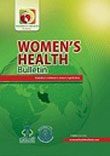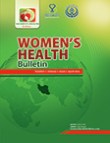فهرست مطالب

Women’s Health Bulletin
Volume:3 Issue: 2, Apr 2016
- تاریخ انتشار: 1395/01/26
- تعداد عناوین: 7
-
-
Page 1
-
Page 2Context: Carpal tunnel syndrome (CTS) is a common neuropathy accounting for up to 90% of all entrapment neuropathies of the upper limb. Identifying potential risk factors might aid in the prevention of this injury. This systematic review aims to identify the current known non-occupational risk factors for CTS as published in three electronic databases.
Evidence Acquisition: Three electronic databases PubMed, Web of Knowledge, and SpringerLink were searched using the keywords CARPAL TUNNEL SYNDROME RISK for all published articles up to September 2015. Based on the inclusion and exclusion criteria, 2755 unique titles were independently analyzed and narrowed to a final list of 83 articles. Only articles with a level of evidence of I, II, or III were included, in accordance with robust study design and data analysis methods. The level of certainty for each risk factor was determined using previously defined criteria.ResultsA total of 83 articles were included, which defined 29 individual, non-occupational risk factors. Only sex and previous musculoskeletal disorder/injury were found to have a moderate level of certainty to modify the risk of CTS. All other risk factors were evaluated as having a low level of certainty.ConclusionsConsidering the large number of studies reporting on non-occupational CTS risk factors as well as the differences in reporting between studies, a lack of consistency is observed in the current review. This review does, however, offer a broad outlook on the literature and the current evidence for risk factors commonly believed to be associated with altered CTS risk. Although several risk factors are commonly believed to be associated with altered risk of CTS, the current evidence to support these beliefs is limited. Prospective cohort studies, larger sample sizes, and consistent and robust measures of risk should be used in future research.Keywords: CTS, Entrapment Neuropathy, Risk, Biological, Medical Condition, Wrist, Injury -
Women Are More at Risk of Poor Mental Health: Mental Health of Spanish Nurses Measured by the GHQ-12Page 3BackgroundMental health is one of the principal indicators of peoples quality of life. One of the professions most commonly associated with mental health problems is nursing.ObjectivesWe analyzed mental health in a group of female and male nurses from a hospital in Madrid (Spain) to evaluate whether differences exist between the groups. Furthermore, there is an analysis regarding whether the variables affecting mental health in female nurses are different from those affecting male nurses.
Patients andMethodsThe research is non-experimental, observational, with a cross sectional and descriptive analysis. The GHQ-12 instrument was chosen for the analysis of mental health in male and female nurses. The GHQ-12 has been validated in the Spanish population.ResultsMale and female professional nurses scored worse in mental health than the population as a whole. Female nurses had worse scores than male nurses. Mental health in male nurses is related to age, self-perceived health, stress at work, and job satisfaction. The variables related to mental health in female nurses are stress at work and rest/sleep.ConclusionsThe variables explaining the state of mental health in female and male nurses are different. The only variable in both regression equations is stress at work, and even then it has different magnitudes for male and female nurses. An awareness of possible quantitative and qualitative differences in the mental health of male and female nurses will contribute to the optimal design of more efficient, evidence-based treatments geared to improving the health of these professionals.Keywords: Mental Health, Nurses, Gender -
Page 4BackgroundTwenty percent of married couples at reproductive age suffer from infertility. This common problem might cause significant problems in couples mental health and quality of life.ObjectivesAccordingly, the goal of the present study is to evaluate the frequency of marital maladjustment in these patients in Shiraz, Iran.
Patients andMethodsThis cross-sectional study was performed on 100 infertile couples (with a mean age of 33.39 ± 6) randomly selected from those referred to Ghadir Mother and Child hospital, from March 2011 to March 2012. All of them completed the dyadic adjustment scale (DAS) and a demographic questionnaire. Data were analyzed using SPSS software, using frequency, percent, and t-tests.ResultsAll the patients declared that they had maladjustment in their marital relationship. Although the cut-off point of the questionnaire is 100, the mean score was 51.32. This maladjustment revealed no gender differences, but in the dyadic consensus score, patients who lived in urban areas and were employed had a significantly higher mean than those who resided in rural areas and were unemployed. In addition, highly educated couples had a higher level of marital adjustment.ConclusionsMarital adjustment is one of the most important factors impacted by the infertility of one or both partners. Marital adjustment impairment is affected by the social, economic, and demographic characteristics of couples. Strategies that target lifestyle modifications may improve the marital life of infertile couples and save their marriages from corruption.Keywords: Infertility, Marital Maladjustment, Demographic Factors -
Page 5BackgroundBreast cancer is one of the most common malignancies all over the world. The rate of survival of the patients with cancer has increased due to developing diverse treatment methods, as a result of which the treatment-related side effects have become the focus of attention more than before. Lymphedema related to breast cancer is one of the frequent side effects which has significantly affected the patients quality of life.ObjectivesThe purpose of this research was to assess the effect of complete or complex decongestive therapy on breast cancer-related lymphedema and the patients quality of life.
Patients andMethodsThe present study was conducted from January 2013 to January 2014 and comprised 119 patients with breast cancer, related lymphedema, who had undergone complete or complex decongestive therapy (CDT). The patients volume and grade of lymphedema were measured and determined before and after treatment, using the direct volumeter device to measure the lymphedema volume. To determine the quality of life, the European organization for research and treatment of cancer quality of life questionnaire (EQRTC BR-23) was completed before and after the treatment.ResultThe volume of lymphedema was significantly reduced after CDT (PConclusionsIt is concluded that not only CDT causes reduction in lymph edema volume but also it improves the life quality of patients with breast cancer-related lymphedema.Keywords: Lymphedema, Quality of Life, Breast Cancer, Complex Decongestive Therapy -
Page 6BackgroundAging is a process in which the bodys physiological capacity continuously decreases after the age of 30. However, interventions such as physical activity can play an important role in the prevention of aging.ObjectivesThe purpose of this study was to compare the effects of eight weeks of combined training (endurance and resistance) in different orders on inflammatory factors and adipokines among elderly females.
Patients andMethodsThe design of this study was quasi-experimental. Forty healthy females were selected purposely and randomly assigned to one of four groups including strength after endurance training (E S, n = 9), strength prior to endurance training (S E, n = 10), circulation combined (CI, n = 12), and control (n = 9) groups. The training program was performed for eight weeks, three times per week. Within-group differences were analyzed using a paired samples t-test and between-group differences were analyzed using one-way analysis of variance (ANOVA).ResultsThe data analysis showed that the between group comparison did not influence the adaptive response of tumor necrosis factor (TNF)-α (P = 0.80), high sensitivity-C reactive protein (hs-CRP) (P = 0.55), adiponectin (P = 0.33), chemerin (P = 0.56), omentin (P = 0.51), leptin (P = 0.10) and vaspin (P = 0.70) levels, yet the within group comparison showed a significant difference in the chemerin concentration in the E group (P = 0.03).ConclusionsThe results indicated that three different combined trainings (strength and endurance) had no positive effect on inflammatory factors and adipokines among aged females. However, the different combined trainings, independent of order, were effective training methods in reducing body fat and body mass index (BMI) in aged females.Keywords: Combined Training, Immunity, Adipocytokines, Elderly, Women


